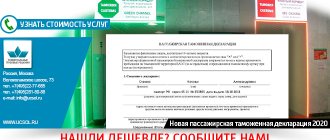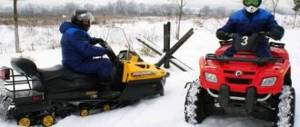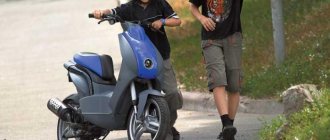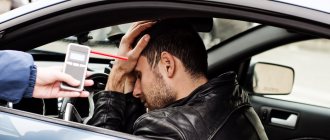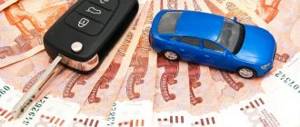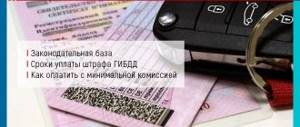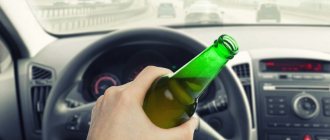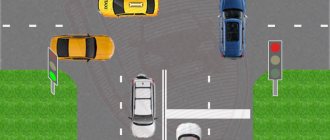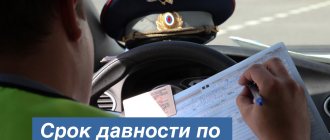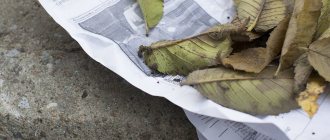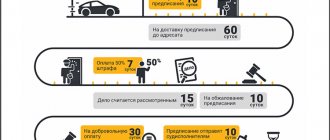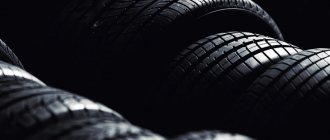Home / Autolight
Back
Published: 03/31/2021
Reading time: 5 min
0
1365
- Is it possible to install strobe lights on a car?
- What are the fines for strobe lighting?
- How to use it correctly so you don’t get fined
- Who can drive with a strobe light
- How to get away with punishment
The penalties for strobe lights of certain colors are significant enough that many drivers believe that installing them is illegal. In fact, there are a number of nuances, knowledge of which will allow you to avoid deprivation of rights and receive the minimum possible penalty or even do without a fine.
What is the penalty?
Special signals can be light or sound . They are supplied using a special device, the installation of which requires permission. You can get it from the traffic police department. After reviewing the documents, the traffic police officer will put the necessary mark on the registration certificate, after which the driver acquires the right to use a special signal. Their use without permission is strictly prohibited and is subject to fines.
For installation on a car
Even if you simply install an unauthorized signal on your car, you will be fined (Article 12.4 of the Administrative Code, Part 2). Individuals who detect violations of this kind will pay 5,000 rubles. Officials are punished with a large amount - for them the fine will be 20,000 rubles. Legal entities will be required to pay 500,000 rubles.
For driving a car
A motorist who dares to drive a car with a signaling device without a permit issued in accordance with the rules risks losing his license for a period of 12-18 months (Article 12.5 of the Administrative Code, Part 4). The devices will be confiscated. Liability also arises if the devices are available but not put into operation. Otherwise, the punishment will be more severe.
When driving
If you turn on a special signal installed in violation of the rules, the deprivation of rights will be for a period of 18 to 24 months. Devices will be confiscated . Responsibility arises in accordance with Article 12.5 of the Administrative Code, Part 5.
For serving while driving
Using devices to signal using light or sound while driving a car, you risk getting a fine if you do not have special permission. If it is not registered with the traffic police, the responsible person may be deprived of the right to drive a vehicle for a period of 1.5-2 years, while devices that violate the rules are subject to confiscation. Responsibility is administrative; for imposing punishment, Article 12.5, Part 5 of the Code of Administrative Offenses is applied.
Reference .
If the fine is paid within 20 days from the date of the decision, its size will be halved. In situations where the execution of a court order is delayed or is carried out in installments, the fine is paid in full.
When is orange flashing lights allowed?
There is a list of situations in which it is necessary to use orange flashing lights, and it is clearly stated in clause 3.4 of the traffic rules:
Quote: 3.4. A yellow or orange flashing light must be turned on on vehicles in the following cases:
- performing work on the construction, repair or maintenance of roads, loading damaged, faulty and moving vehicles;
- transportation of large cargo, explosive, flammable, radioactive substances and highly dangerous toxic substances;
- escort of vehicles transporting large, heavy and dangerous goods;
- accompanying organized groups of cyclists during training events on public roads;
- organized transportation of a group of children.
- An illuminated yellow or orange flashing light does not provide an advantage in traffic and serves to warn other road users of danger.
We draw your attention to the word “should” in paragraph 3.4 - this is an important point! If in the situations listed above, the vehicle does not have an orange or yellow flashing light, this will be considered a violation of traffic rules.
There are a number of situations when a yellow flasher should be on a car:
- Road is up;
- The road is being constructed or reconstructed;
- During road maintenance work: sweeping the road surface, washing it, removing snow;
- If the car accompanies an organized group of cyclists;
- When the tow truck is working. This applies to the loading of faulty or damaged transportable vehicles;
- On escort vehicles during the transportation of dangerous, heavy, large-sized cargo;
- On vehicles transporting toxic, large, flammable, explosive, radioactive cargo;
- During organized transportation of children on buses.
For reference! As you noticed, the traffic rules do not prohibit the use of an orange flashing light in other cases.
It is important to know that if you need to attract additional attention to your vehicle, you are allowed to turn on the yellow beacon. BUT! It will not give you any advantage on the road. But there are still positive aspects.
For example, a driver is involved in a traffic accident and needs prompt assistance from an emergency commissioner. He dials the number of the Unified Service of Emergency Commissioners, and an emergency response team arrives to him as soon as possible. Whatever one may say, our mentality is designed in such a way that any flashing lights attract the attention of other road users, and drivers, willy-nilly, slow down, and some calmly let the vehicle pass. Moreover, the emergency commissioner’s car most often has a corresponding inscription, and those who have been in an accident before and contacted the emergency commissar understand where he is rushing - to help people who are in trouble on the road! Of course, an emergency response vehicle has no advantage on the road, but it can get to the scene of an accident faster than a regular car.
The advantages of this are obvious: the emergency commissioner on site will quickly assess the current situation, take the necessary photographs and videos, after which the road can be cleared of damaged cars and debris, if any. As you know, under no circumstances should they be removed or moved until the accident has been reported in accordance with the law. And only a professional can do this in the shortest possible time: either a traffic police officer or an emergency commissioner. But since recently not all accidents require calling the traffic police, the services of an emergency commissioner in Crimea are in demand more than ever. Moreover, on the Tavrida highway there are many sections where either reconstruction or repair work is underway, so the number of accidents in such places is not encouraging.
Concept of sound signal
In regulations, special signals are given the following definition - flashing beacons , can be blue-red or only blue, and can be equipped with a device for transmitting sound. A special signal is a combination of light and sound that foretells the approach of a police car, ambulance, or fire brigade. Equipment equipped with such a signal has a special status. If special conditions are met, all other vehicles are required to give way to them.
The GOST provision, which contains a description of the concept, applies to passenger cars, as well as motorcycles and buses belonging to operational services.
According to the rules, a device for delivering special sound signals is a device capable of producing sounds of a certain spectral composition. It does not apply to the structural elements of the vehicle - the special one differs from the usual sound signal in the spectrum of sounds (clause 11, article 3 of GOST). Installation is carried out according to a permit issued by the traffic police.
Flashing beacons - “flashing lights” are used to provide light signals and must have colors established by GOST , a certain duration of illumination and frequency of blinking (clause 12 of article 3 of GOST). The light device does not belong to the elements that are included in the design of the vehicle. For installation you must obtain a special permit.
Types of "flashing lights"
- Blue (for services 01, 02, 03, 04).
- Red and blue (traffic police, FSB, escort vehicles intended for organized convoys).
- Orange and yellow (evacuation, road special equipment, vehicles carrying cargo of non-standard dimensions, dangerous, with considerable weight).
- White-lunar signal (used for cash collection vehicles, FPS transport).
Orange, white and yellow “flashing lights” are not special signals and do not provide any advantage when driving on roads. Such signals are used only for the convenience of driving on roads. Drivers of special equipment equipped with such devices may not follow some rules when driving.
Look at the topic - What is the fine or deprivation of rights for using special signals on a car according to traffic rules?
The use of special signals as of 2021 is prohibited by traffic regulations. But not only their use is punishable by fines and deprivation of the right to drive, but also driving a car with installed emergency services beacons, as well as sound “quacks”. For each of these actions and violations you can receive a very serious sanction. Also, almost always, both a fine and deprivation are accompanied by confiscation of the device for giving a special signal. But let's talk about everything in order!
What is prohibited from using special signals and what do traffic regulations say?
In fact, the Rules prohibit their installation. The basic provisions for the admission of vehicles prescribe the following:
11. Operation is prohibited:
- ….
- vehicles equipped without appropriate permission ... with flashing lights and (or) special sound signals.
Please note that only certain services have permission to use special signals. Their list was approved by Decree No. 635 of the President of Russia. This includes both operational services, including police, ambulance, Ministry of Emergency Situations and others, as well as the security of high-ranking officials and even the Academy of Sciences.
But not every device is a special signal! It is necessary to distinguish between the approved color and operating mode of beacons or “quacks” and simply lighting devices in strobe mode, loudspeakers, and the like. Although the use of both types of such devices while driving a car entails deprivation of rights, the terms of such deprivation are different, and additional penalties are also different.
We will not give here a complete list of all possible special signals, but it is obvious that red, blue, yellow colors in the form of beacons, as well as other colors that you see on the road on specially equipped cars are special signals.
Now is the time to talk about possible sanctions. Let's first look at the minimum threshold of penalties for this - fines, and then list what people are deprived of their rights for.
What are the fines for installing special signals on cars?
Among the forms of relevant traffic violations in 2021, 3 main groups can be divided:
- installation of special signals for emergency services,
- driving a vehicle equipped with flashing lights or special sound “quacks”,
- use of these signals – both while moving and when the vehicle is stationary.
Terms of use
The installation is considered legal if the owner of the car has bothered to obtain the appropriate permission from the traffic police . Transport belonging to official organizations undergoes the necessary checks in a timely manner to obtain documents. Devices called special signals and used to provide light or sound signals must be certified in accordance with the rules approved by Gosstandart.
The instructions for obtaining permission to use special signals are approved by Order of the Ministry of Internal Affairs No. 194. This fact must be confirmed by a special mark in the vehicle registration certificate. When stopping such vehicles, traffic police representatives will be able to immediately establish the fact of illegal use of equipment.
Reference . A non-certified device cannot be called a “special sound/light signal”. It does not belong to the category of special signals. In controversial situations, lawyers can use this fact as a loophole to build a defense.
Who should?
Sound special signals can be used by drivers of vehicles of government organizations , such as the FSB, police, Prosecutor General's Office, Ministry of Defense, Ambulance, firefighters and other organizations that have the authority to carry out urgent actions to protect the lives of citizens and their health.
Decree of the President of the Russian Federation N 635 in paragraphs. b of paragraph 3 establishes on which vehicles a special signal can be installed, here it is necessary to take into account the amendments to this decree dated 04/06/2019 in connection with the publication of Government Resolution 408.
The changes affected passenger vehicles of professional emergency rescue services and professional emergency rescue units not included in the system of the Ministry of the Russian Federation for Civil Defense, Emergencies and Disaster Relief, devices for supplying special light and sound signals in the presence of special colorographic schemes on the outside the surfaces of these vehicles are not installed.
So, let's look at an excerpt from the Decree and see who is allowed to install a special signal.
The following equipment is equipped with devices for supplying special light and sound signals in the presence of special color schemes on the outer surface of vehicles:
- vehicles of the fire department, police, emergency medical care, professional emergency services, professional emergency rescue units, military automobile inspection, military police of the Armed Forces of the Russian Federation, troops of the National Guard of the Russian Federation, investigative bodies of the Investigative Committee of the Russian Federation, used for the implementation of urgent actions to protect the life and health of citizens;
- special operational and service vehicles of the penal system for transporting persons in custody;
Are FSO outbreaks legal?
Whether FSO flashes are legal or not is a very pressing question for many car owners. The law does not directly prohibit their installation, but there are many nuances here.
From a legal point of view, it is most justified to connect such headlights as additional high beams. This is permitted under a number of laws. For example, the provisions of GOST 8769-75 define the following requirements for such devices.
- Cars and other vehicles (except trailers) must have 2 or 4 high beam headlights. Any other quantity (for example, 3) is prohibited.
- It is permitted to use headlights with a total luminous intensity of no more than 225,000 cd.
- Only white and yellow lights are allowed, the rest are prohibited.
- It is prohibited to install the emitter closer to the side dimensions than the low beam source.
If the specified conditions are met, then the use of FSO flashes is permitted. In this case, they should turn on simultaneously with the high beam and turn off when the low beam is turned on. They should also not block markers or other lights. In this case, the legality of their installation is not questioned.
Many car owners install FSO flashes in other configurations and modes. Is this legal? If you turn on such additional lights in the city, you risk getting fined. But their use in off-road conditions is not prohibited by anyone. Therefore, on rough terrain they can be used without restrictions.
It is most convenient to install FSO flashes under the radiator grille or along the perimeter of the car body. It is important that they do not block any other light or signal lights.
Controversial situations of traffic violations
If controversial situations arise, you can seek the services of an experienced lawyer to protect your interests in court. For example, if you are charged with the illegal use of special signals, the defense is sometimes based on the fact that the installed device is not one.
According to the characteristics, special signals include signals that, when turned on, change their tone with a certain frequency. Information about this can be found in GOST R 41.28-99. If the characteristics specified in the technical data sheet of the device do not comply with GOST, the person cannot be accused of using special signals.
Option - a device that does not comply with GOST may be called a dummy . If, for example, there are no structural elements in it, it does not apply to special signals. There is no liability for the installation of dummies.
The driver can also file a complaint against representatives of the traffic police if he believes that the procedure for bringing him to administrative responsibility has been violated. The complaint is submitted to higher authorities; it is better to go directly to the court. The decision will be made based on the circumstances surrounding the specific situation.
How can the traffic police prove guilt?
A vehicle, when stopped by traffic police officers, can be checked for violations. Representatives of regulatory authorities can check whether they are installed in violation of accepted rules. The fact of illegal use of the device is very easy to establish - you just need to check the documents for the car.
Copies of documents confirming the violation can be attached to the protocol left at the place where the vehicle was detained - a vehicle registration certificate that does not have a mark authorizing special signals. At the discretion of traffic police officers, photos, videos, and witness statements may be attached.
The procedure for using special light and sound signals
The procedure for using special light and sound signals on public roads is regulated by clause 3 of the Traffic Regulations of the Russian Federation and is as follows:
- those who have the right to a blue car beacon, if absolutely necessary, can ignore traffic lights and demand to give way to them in violation of the rules;
- the same is permitted for vehicles accompanied by cars with blue or red lights;
- Special vehicles can violate traffic rules only after making sure that they are given way;
- the light signal on such a machine must be supplemented by the inclusion of sound;
- When a special vehicle approaches, other vehicles must move to the side or slow down to let it pass;
- It is prohibited to overtake emergency vehicles driving with working signals;
- if it is stationary, but the beacon and siren are on, an ordinary car should reduce speed as it approaches;
- yellow and orange beacons do not give priority in travel, but vehicles with them can, if necessary, ignore markings and road signs, except for 2.2, 2.4 - 2.6, 3.11 - 3.14, 3.17.2, 3.20;
- they may also not comply with the rules of paragraphs 9.4-9.8 and 16.1 of the traffic rules, if this does not threaten traffic safety;
- white beacons on Russian Post vehicles, collector vehicles carrying valuable cargo can be turned on only if there is a threat of attack on them;
- The cars listed in the previous paragraph do not have access rights.
Watch this video about traffic rules when using special signals:
Useful video
The video below explains what fines are imposed for installing and using a special signal without permission.
The safety of all road users depends on the correct operation of headlights and signal lights. Read articles from our experts about what the fine is for violating the use of lighting devices such as: xenon, the presence of diode bulbs in the headlights, not turning on the turn signal and driving in the wrong direction, for tinting the rear lights or front optics, non-working low or high beams or driving in daytime with no lights on.
Rules for using flashing beacons
The current procedure allows for the installation and practical use of special signals on vehicles of the following services and departments:
- emergency;
- law enforcement agencies, including the police, traffic police, FSB and military prosecutor's office;
- Ministry of Emergency Situations and fire departments of the ministry;
- government structures belonging to the highest echelons of the executive, legislative and judicial authorities.
The inclusion of flashing beacons is permitted only for official reasons. The mode of practical use depends on the type of special signal.
